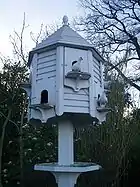Puerto Octay | |
|---|---|
|
 Coat of arms  Location of Puerto Octay commune in Los Lagos Region  Puerto Octay Location in Chile | |
| Coordinates (town): 40°58′S 72°54′W / 40.967°S 72.900°W | |
| Country | Chile |
| Region | Los Lagos |
| Province | Osorno |
| Founded | 22 December 1891 |
| Government | |
| • Type | Municipality |
| • Mayor | Gerardo Gunckel (Independent) |
| Area | |
| • Total | 1,795.7 km2 (693.3 sq mi) |
| Population (2002 Census)[2] | |
| • Total | 10,236 |
| • Density | 5.7/km2 (15/sq mi) |
| • Urban | 3,403 |
| • Rural | 6,833 |
| Sex | |
| • Men | 5,391 |
| • Women | 4,845 |
| Time zone | UTC-4 (CLT[3]) |
| • Summer (DST) | UTC-3 (CLST[4]) |
| Area code | 56 + 64 |
| Climate | Cfb |
| Website | Municipality of Puerto Octay |
Puerto Octay is a town and commune in Osorno Province located on the north shore of Llanquihue Lake in Los Lagos Region in the south of Chile. It was settled by German colonists in 1852. Puerto Octay was an important port with regular traffic to Puerto Varas before the railway opened in 1912.
History
Its origin dates back to the German colonization in 1852 driven by Bernhard Philippi. Years later it became one of the major ports on Lake Llanquihue. On 22 December 1891 the municipality was established, under the Presidency of the Republic Jorge Montt.[5]
German heritage history

Puerto Octay currently has a rich and varied architecture, mostly built of wood, which is the historical reflection of the colonization process, driven by the State of Chile in the mid-nineteenth century, with families coming from Germany.
Some prominent buildings are the House Niklitschek, Hotel Haase, Wulf House, the current Colegio San Vicente de Paul and Werner House. What is extraordinary about this city is that despite the lapse of more than 100 years, it is still possible to assess this type of buildings.
In order to preserve this architectural heritage, Puerto Octay is currently in the process of being declared a Typical Zone. This will identify a representative area of identity and history, which will be legally protected by the State of Chile.
Flora and fauna

Birds: thrush, dove, parrot, rooster from the mountain (extinct), kestrel, heron, sparrows, swallows.
Tourism

Referring to tourism in the district lake, Lake Llanquihue has beautiful beaches for vacations, fishing and water sports. The most notable include Rupanco Islet, La Baja, Puerto Maitén and Fonck.
Demographics
According to the 2002 census of the National Statistics Institute, Puerto Octay spans an area of 1,795.7 km2 (693 sq mi) and has 10,236 inhabitants (5,391 men and 4,845 women). Of these, 3,403 (33.2%) lived in urban areas and 6,833 (66.8%) in rural areas. The population fell by 7.4% (815 persons) between the 1992 and 2002 censuses.[2]
Administration
As a commune, Puerto Octay is a third-level administrative division of Chile administered by a municipal council, headed by an alcalde who is directly elected every four years.[1]
Within the electoral divisions of Chile, Puerto Octay is represented in the Chamber of Deputies by Fidel Espinoza (PS) and Carlos Recondo (UDI) as part of the 56th electoral district, together with Puyehue, Río Negro, Purranque, Fresia, Frutillar, Llanquihue, Puerto Varas and Los Muermos. The commune is represented in the Senate by Camilo Escalona Medina (PS) and Carlos Kuschel Silva (RN) as part of the 17th senatorial constituency (Los Lagos Region).
References
- 1 2 "Municipality of Puerto Octay" (in Spanish). Archived from the original on 10 November 2000. Retrieved 13 December 2010.
- 1 2 3 4 "National Statistics Institute" (in Spanish). Retrieved 13 December 2010.
- ↑ "Chile Time". WorldTimeZones.org. Archived from the original on 13 July 2010. Retrieved 26 September 2010.
- ↑ "Chile Summer Time". WorldTimeZones.org. Archived from the original on 11 September 2007. Retrieved 26 September 2010.
- ↑ (in Spanish) Puerto Octay, Un Recodo Alemán Archived 2 February 2002 at the Wayback Machine
